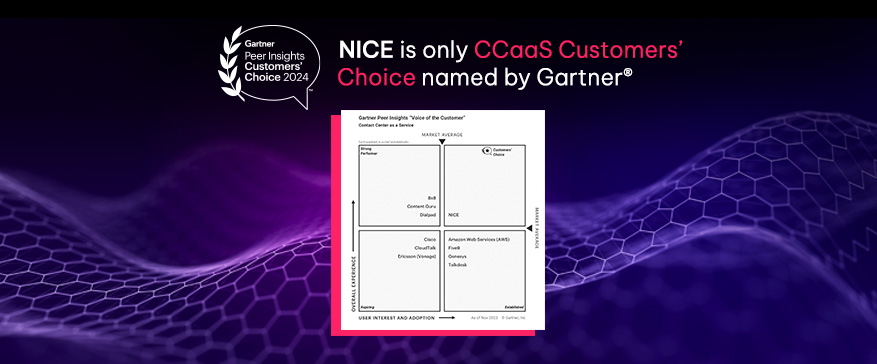Alzheimer’s Society Delivers Crucial Services Through NICE CXone
What Is Call Center Monitoring Software?
Call center monitoring software is a solution designed to track and analyze phone interactions between call center agents and customers. This call monitoring software helps businesses ensure that customer service representatives provide high-quality interactions, adhere to company protocols, and resolve issues efficiently. Call center monitoring software aggregates real-time and historical data from phone calls and offers valuable insights into call quality, agent performance, and customer satisfaction.The primary goal of call center monitoring software is to improve agent performance and overall service quality by tracking interactions, identifying areas for improvement, and providing managers with tools to support agents in real-time.Definition of Call MonitoringCall monitoring is the process of tracking and analyzing customer calls to assess customer service interactions across different channels. It involves collecting, analyzing, and leveraging data from contact center communications to evaluate agent performance levels and the overall customer experience. Call monitoring is essential for running successful contact centers and call centers, as it helps identify areas for improvement, optimize processes, and provide better customer service.How Call Center Monitoring Software WorksCall center monitoring software, often referred to as a call monitoring system, works by integrating with telephony systems and customer relationship management (CRM) tools, consolidating data into a single interface that provides real-time visibility into call center operations. Here’s a detailed breakdown of how this software typically functions:- Real-Time Monitoring: Managers can access a live dashboard that displays the status of all ongoing calls, allowing them to monitor real-time metrics such as call volume, wait times, and agent availability. This enables them to identify potential issues and make necessary adjustments during peak call times.
- Call Recording and Evaluation: The software automatically records calls for review and analysis. Recordings provide valuable feedback to both agents and supervisors, ensuring that calls meet quality standards and are compliant with regulations.
- Agent Performance Metrics: The software tracks key performance indicators (KPIs) for each agent, including call handling time, first-call resolution, and customer satisfaction scores. This data is used to evaluate and improve agent performance.
- Silent Listening and Coaching: Managers can silently listen to ongoing calls without the agent or customer knowing. In addition, they can provide real-time coaching to agents via the “whisper” function, offering guidance on how to improve interactions without the customer hearing it.
- Post-Call Analytics: After each call, the software analyzes the data, providing managers with actionable insights. Reports may include customer sentiment, agent adherence to scripts, and resolution effectiveness.
- Compliance and Quality Assurance: In regulated industries, compliance with data protection laws and call handling protocols is essential. Call center monitoring software ensures that all calls are recorded and adhere to legal standards.
Key Features of Call Center Monitoring Software
Call quality monitoring software is packed with advanced features designed to optimize call center operations and ensure high-quality service. Here are the key features that businesses should look for:1. Real-Time Call Monitoring and DashboardsReal-time monitoring is a core feature of call center monitoring software, allowing managers to monitor the call center's ongoing calls and assess agent performance. A dashboard provides a comprehensive view of the call center’s operations, including active calls, agent availability, and key metrics.- Live Call Status: Managers can see which agents are on calls, which are idle, and which are on breaks, helping to manage workload distribution effectively.
- Call Duration and Wait Time: Real-time tracking of call duration, wait time, and hold time ensures that issues are promptly addressed.
- Quality Assurance: Managers can use call recordings to assess agent performance based on set standards, such as proper call greeting, use of script, and issue resolution.
- Training and Development: Call recordings serve as valuable training resources for new agents and can be used to highlight areas for improvement.
- On-the-Spot Coaching: The whisper feature allows managers to provide guidance to agents during calls. For example, if an agent struggles with answering a question, the supervisor can offer tips in real-time without the customer hearing.
- KPIs: Metrics like average call duration, first-call resolution, customer satisfaction, and abandonment rate are tracked and analyzed to measure the effectiveness of call center operations.
- Trend Analysis: The software can help identify trends in customer behavior, peak call times, or common issues that need attention, enabling proactive decision-making.
- Agent Evaluation: Evaluation forms can include criteria like adherence to scripts, professionalism, tone of voice, and problem resolution. Each call is scored to provide feedback to agents.
- Customer Satisfaction: Businesses can integrate post-call surveys to gather direct feedback from customers, adding an extra layer of insight into the quality of service.
- Call Recording for Compliance: Recordings of all customer interactions can be stored securely for future review, ensuring that businesses comply with legal and regulatory standards.
- Regulatory Adherence: The software can be set up to monitor whether agents are following required scripts, disclaimers, and other legal requirements during customer interactions.
Benefits of Call Center Monitoring Software
Implementing call monitoring systems and call center monitoring software brings a host of advantages that can significantly improve call center operations, agent performance, and customer satisfaction. Here are some of the key benefits:1. Improved Agent PerformanceBy monitoring real-time interactions, providing instant feedback, and analyzing performance metrics, call center monitoring software helps improve center agent performance.- Real-Time Support: Managers can provide immediate guidance during calls to help agents navigate difficult situations and improve customer service.
- Continuous Improvement: Regular evaluation of calls helps agents identify areas for improvement and develop better customer engagement skills.
- Faster Issue Resolution: Real-time monitoring helps agents handle issues more efficiently, reducing customer wait times and improving resolution rates.
- Personalized Service: With access to customer data and previous interactions, agents can provide more personalized support, improving customer satisfaction.
- Informed Decision-Making: Analytics tools help managers make data-driven decisions about staffing, training, and operational improvements.
- Agent Performance Tracking: With real-time metrics, businesses can track agent productivity and identify top performers who can serve as models for others.
- Audit Trails: Call recordings and interaction logs create an audit trail, which businesses can reference in case of compliance audits or legal reviews.
- Regulatory Adherence: Monitoring agents’ adherence to scripts and legal guidelines helps businesses avoid costly fines and penalties.
- Optimized Resource Allocation: Real-time data on call volumes and wait times helps businesses allocate resources effectively, ensuring that staffing levels align with demand.
- Improved Operational Efficiency: Monitoring software enables businesses to optimize workflows, reduce call handling time, and increase the number of calls handled per agent.
How to Select a Call Center Monitoring Solution
Selecting the right call center monitoring solution is crucial for effective call monitoring. Here are some factors to consider when choosing a call monitoring solution:Factors to Consider When Choosing a Call Monitoring Solution- Ease of Use: The solution should be intuitive and user-friendly, allowing agents and supervisors to navigate the interface effortlessly and access necessary tools quickly.
- Comprehensive Call History: A good call monitoring solution should offer detailed call logs, providing insights into call progress, duration, and outcomes.
- Call Recording: The ability to record calls is essential for evaluating agent performance and ensuring compliance with quality standards.
- Live Metrics: Real-time data on call volume, average speed to answer, and other key metrics help supervisors make informed decisions on the fly.
- Real-Time Assistance: The solution should enable supervisors to provide real-time guidance to agents during calls without interrupting the customer interaction.
- Scalability: As your business grows, the call monitoring solution should be able to scale accordingly, adapting to increased call volumes and additional agents.
- Integration: Seamless integration with existing systems, such as CRM software and helpdesk platforms, ensures a smooth workflow and comprehensive data analysis.
- Security: Protecting customer data is paramount. The solution should comply with industry regulations and offer robust security features to safeguard sensitive information.
Implementing Call Monitoring
Implementing call monitoring requires careful planning and execution. Here are the steps to implement effective call monitoring:Steps to Implement Effective Call Monitoring- Define Your Goals: Clearly outline what you aim to achieve with call monitoring, whether it’s improving customer satisfaction, reducing average handling time, or enhancing agent performance.
- Choose the Right Solution: Select a call monitoring solution that aligns with your specific needs and budget constraints.
- Configure the Solution: Set up the solution to meet your requirements, including call recording, live metrics, and other essential features.
- Train Your Agents: Ensure that your agents are well-trained on the new system and understand how to use it effectively to enhance their performance.
- Monitor and Analyze: Regularly monitor and analyze calls to identify areas for improvement and optimize processes.
- Provide Feedback: Offer constructive feedback to agents based on call monitoring data, and provide coaching and training to help them improve their skills.
- Continuously Evaluate: Regularly assess the effectiveness of your call monitoring solution and make necessary adjustments to ensure it continues to meet your goals.










